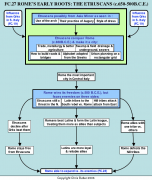FC27: The Etruscans & their influence on Rome (c.800-500 BCE)
Flowchart
Although there is evidence in Roman myth and archaeology of various shepherd villages on Rome's seven hills, the city's history really started with the Etruscans. The origins of this mysterious people are obscure. Some ancient sources liked to trace them back to Asia Minor because of their religious practices such as augury (reading flights of birds to tell the future), style of dress (in particular their pointed shoes which resembled those of the Hittites), their use of the arch in architecture, and their obscure language. However, even to this day, the origins of the Etruscans remain a mystery.
The Etruscans were organized into a loose confederation of city-states to the north of Rome. Around 650 B.C.E., they took control of the site of Rome, with its defensible hills and location on a ford of the Tiber River. They did a number of things to transform this crude collection of shepherds' huts into a true city. The Etruscans introduced rectangular urban planning. They drained the surrounding marshes and built underground sewers. They built public works using the arch and vault, and laid out roads and bridges. They promoted trade, the development of metallurgy, and better agriculture in and around Rome. The Etruscans, being heavily influenced by the Greeks, also introduced the Greek alphabet, thus introducing Greek influence into Roman culture. In fact, Roman nobles during this period would send their sons to be educated in Etruscan schools much as they would later send their sons to Greece for an education. The dark and gloomy Etruscan religion, in particular the custom of gladiators fighting to the death at the funeral of a king or noble, also had a significant impact on Rome. This is seen much later in Christian images of demons that seem to be modeled after Etruscan demons. Overall, the Romans owed a great deal to the Etruscans. The genius they would show for urban planning, road and bridge building, and civil engineering projects such as public aqueducts and baths, was a direct result of the legacy left by the Etruscans.
By 500 B.C.E., the Etruscans had also made Rome most important city in the central Italian region of Latium. This enabled it to dominate its close neighbors, the Latins and finally encouraged it to rebel against its masters. Two other factors aided the Romans in their struggle. First of all, Rome's hills and fortifications helped defend it against attack. Second, the Etruscans' loose organization into a confederacy of independent city-states made them vulnerable to attack by the Greeks in South Italy who were their rivals for trade and sea power.The Greeks won a decisive victory, which allowed Rome to successfully shake off Etruscan rule around 500 B.C.E. or later. However, Etruscan aggression remained a serious threat for the better part of a century. Therefore, it was not until around 400 B.C.E. that Rome was secure enough to embark upon its own path of conquest.


